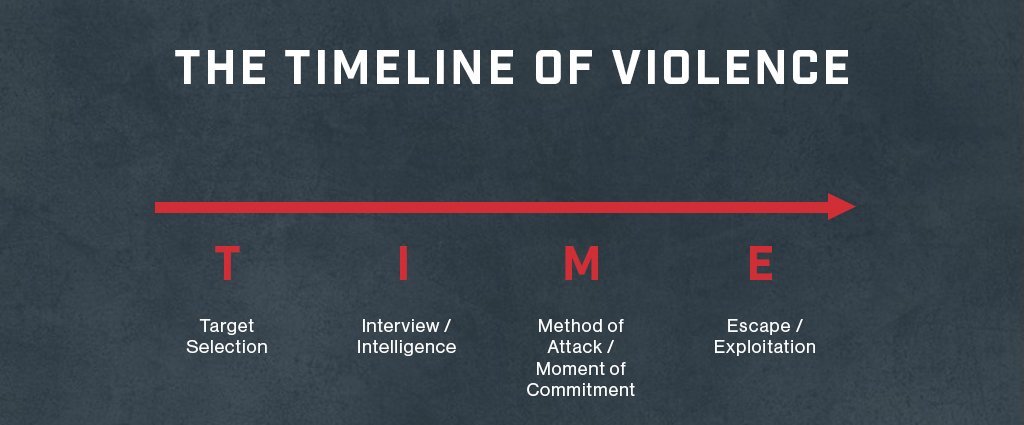The TIME-Line of Violence
The Myth of Randomness - Part 4
In the first three parts of the series (1, 2, 3), we’ve explored who the Bad Guys are, why they do what they do, why they are so careful in their selection of targets, what they are afraid of, and how you can begin to control the situational factors to prevent them from targeting you in the first place.
What we’re going to address now is the specific four-phase process that all Bad Guys go through in the commission of their attacks—a process I call TIME.
TIME stands for Target selection, Intelligence (or Interviewing), Method of attack, and Escape (or Exploitation).
To make sense of this process, let’s consider the 911 terrorists. Imagine one of those terrorists approaching the rest of the group and saying, “I’ve got a great idea. Let’s target the World Trade Center.” This is Target selection. Another from the group comes up with the idea of using airplanes to fly into the buildings. We now have a proposed Method of attack. So the question is why don’t they just go for it? Because obviously there’s an inherently high degree of potential for failure because they haven’t fully vetted their plan. So they enter into what I call the I of TIME.
The I of TIME is where all of the Intelligence gathering is taking place. The surveillance of the target, the training and selection of manpower and weapons, the testing and probing of the target, even the rehearsals needed to see if the plan would be successful (e.g., testing to see whether it’s possible to get through security and board a plane with a box cutter).
Once they have thoroughly vetted their plan and are confident in the mission’s potential for success, they launch the attack and the M of TIME turns from the Method of attack to what we would call the Moment of commitment, where the attackers make their intentions known.
Should the attackers succeed, sometimes there’s an Escape plan in mind. Think about the Parkland shooting, where the shooter intended to drop his weapons and blend into the student population to Escape. Ultimately, it didn’t work out for him, but he nonetheless had an Escape plan set in place. In the case of 9/11, Escape was not the intention; their intention was Exploitation. Here’s what that Exploitation looked like: Osama Bin Ladin and Al Qaeda took credit for the attack and sowed terrorism after the fact. Another example of Exploitation is a school shooter’s manifesto being found in his locker the next day, or a workplace shooter’s manifesto hitting the news media after an attack.
To avoid becoming a victim, the key is that we don’t want to be on the “X,” as we say, at the Moment of commitment—or what Patrick Van Horne and Jason A. Riley refer to as the Moment of Bang in their book Left of Bang: How the Marine Corps’ Combat Hunter Program Can Save Your Life. At the Moment of commitment, the Bad Guys have chosen the time, the place, and the weapons, and we are left reacting. So it’s always better to get ahead of the curve, recognize the warning indicators that an attack is forming, and respond before it manifests.
As we explore this idea, two critical questions emerge:
Do street criminals, predators, and other types of Bad Guys follow the TIME model?
Yes. Their TIME-line just happens faster. Imagine you’re walking down the street and you’re totally unaware that there’s a predator scanning the people coming and going. He could be looking at people thinking, No. No. No. Okay, that one will work. This is Target selection. For this kind of Bad Guy, the I of TIME typically takes the form of what we colloquially call an Interview. Most of the time an Interview takes one of two basic forms. The first is an approach: “Hey, can I talk to you for a sec?” the other is to follow you you to see if you’re even aware that he is there.With Potential Bad Guys, the same TIME process happens, even in what we would classify as mutually combative situations, such as someone challenging you to a fight in a bar. Target selection has definitively occurred, usually for a variety of reasons, and the verbal and non-verbal posturing that typically occurs are elements of the Interview process. How you conduct and manage that Interview is obviously very important to whether or not that situation diffuses or escalates.
The next question is, if this process is universal, can you avoid being targeted in the first place?
Unfortunately, the answer to this question is no. And it’s because the Bad Guy ultimately is in charge of whether or not he chooses to target you. In response to this point, some people like to argue, “But can’t I avoid trouble in the first place?” Of course the answer is yes, to a degree. We can’t control this factor, but we can influence it. We can be respectful of people. We can avoid confrontations. We can avoid walking down those dark alleys and stay away from potentially dangerous situations. But the problem is that any one of us can be targeted even when you do everything right.
For example, if you own a business or are in a management position, you may have to terminate someone’s employment. You may even do so in the kindest most positive way possible, preserving his dignity, providing a soft landing, and doing all you can to place him on a positive trajectory. Despite all of that, that person could still come back months or even years later and saying, “When you fired me, you destroyed my life.”
In the domestic context, this might sound like, “If I can’t have you, no one can.” Ultimately, you could do all you can to Deny opportunity and avoid trouble and still be targeted.
The I of TIME is the point where we can truly exercise the greatest control. By recognizing that we are in fact being Targeted, and by managing the situational dynamics of the I of TIME, we can often Deter threats from escalating to violence in the first place.
The key to doing this is to learn how to spot the warning signs that you are in an Interview or witnessing Intelligence gathering. And in my next blog post, that’s exactly what we’ll be doing.



